Advanced Taxation (2019): Tax Avoidance, GAAR, and BEPS Analysis
VerifiedAdded on 2022/10/02
|10
|3498
|160
Essay
AI Summary
This essay provides a comprehensive analysis of tax avoidance in the UK, examining the attitudes towards it in recent years, and critically evaluating the government's response, particularly through the General Anti-Abuse Rule (GAAR). It explores the role of HM Revenue & Customs (HMRC) in managing the risks associated with tax avoidance. The essay further delves into Base Erosion and Profit Shifting (BEPS), assessing its impact and the reactions of the UK government and international bodies. It covers the structure and operation of the UK tax system, including individual taxes, corporate taxes, and international taxation. The essay highlights key factors influencing taxation strategy, including ethical responsibilities and the adoption of competitive business tax policies. The discussion includes an overview of GAAR's functions, the role of the GAAR advisory panel, and the UK's adoption of a competitive business tax policy. The essay also addresses the UK's support for the OECD BEPS project and its impact on multinational tax avoidance.
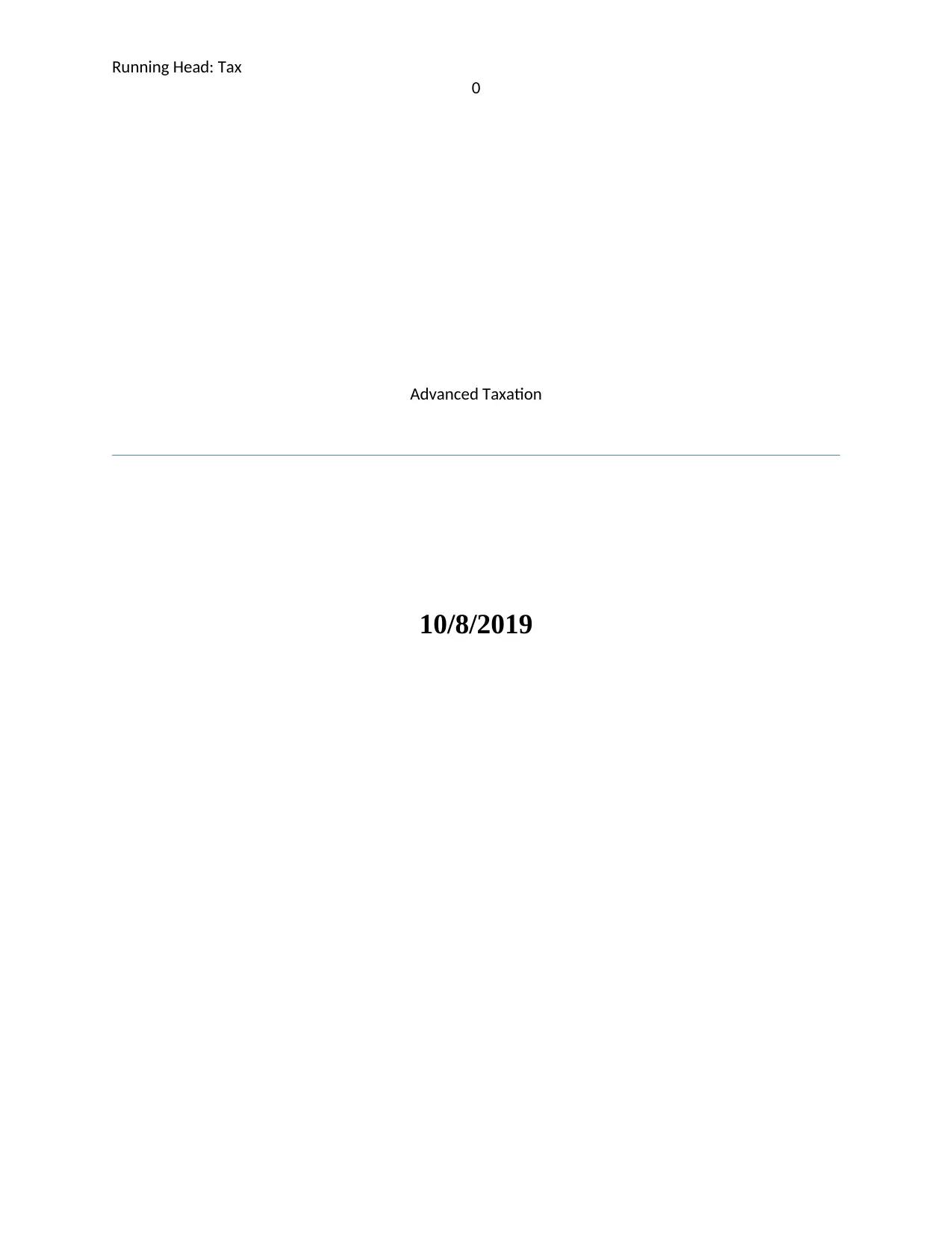
Running Head: Tax
0
Advanced Taxation
10/8/2019
0
Advanced Taxation
10/8/2019
Paraphrase This Document
Need a fresh take? Get an instant paraphrase of this document with our AI Paraphraser
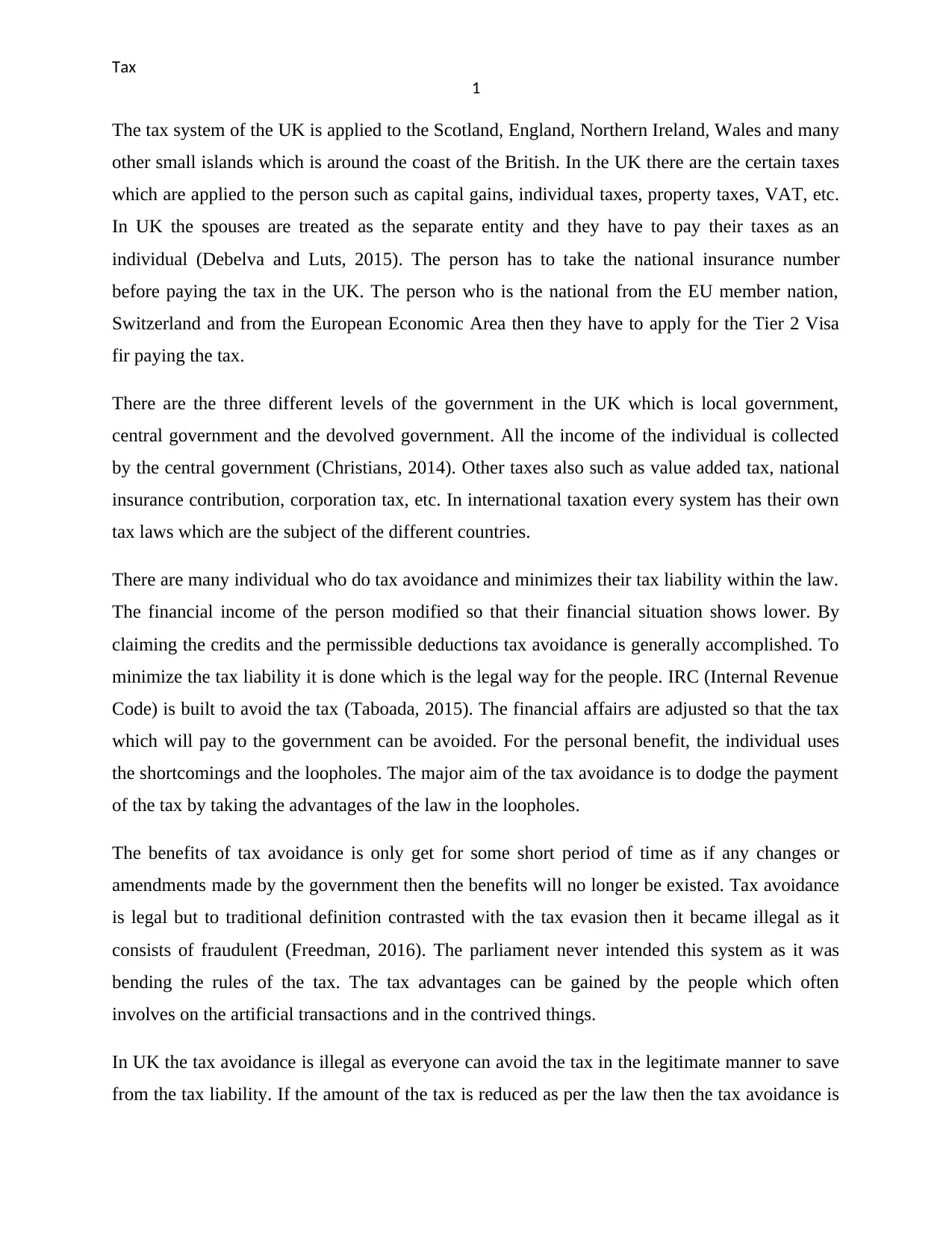
Tax
1
The tax system of the UK is applied to the Scotland, England, Northern Ireland, Wales and many
other small islands which is around the coast of the British. In the UK there are the certain taxes
which are applied to the person such as capital gains, individual taxes, property taxes, VAT, etc.
In UK the spouses are treated as the separate entity and they have to pay their taxes as an
individual (Debelva and Luts, 2015). The person has to take the national insurance number
before paying the tax in the UK. The person who is the national from the EU member nation,
Switzerland and from the European Economic Area then they have to apply for the Tier 2 Visa
fir paying the tax.
There are the three different levels of the government in the UK which is local government,
central government and the devolved government. All the income of the individual is collected
by the central government (Christians, 2014). Other taxes also such as value added tax, national
insurance contribution, corporation tax, etc. In international taxation every system has their own
tax laws which are the subject of the different countries.
There are many individual who do tax avoidance and minimizes their tax liability within the law.
The financial income of the person modified so that their financial situation shows lower. By
claiming the credits and the permissible deductions tax avoidance is generally accomplished. To
minimize the tax liability it is done which is the legal way for the people. IRC (Internal Revenue
Code) is built to avoid the tax (Taboada, 2015). The financial affairs are adjusted so that the tax
which will pay to the government can be avoided. For the personal benefit, the individual uses
the shortcomings and the loopholes. The major aim of the tax avoidance is to dodge the payment
of the tax by taking the advantages of the law in the loopholes.
The benefits of tax avoidance is only get for some short period of time as if any changes or
amendments made by the government then the benefits will no longer be existed. Tax avoidance
is legal but to traditional definition contrasted with the tax evasion then it became illegal as it
consists of fraudulent (Freedman, 2016). The parliament never intended this system as it was
bending the rules of the tax. The tax advantages can be gained by the people which often
involves on the artificial transactions and in the contrived things.
In UK the tax avoidance is illegal as everyone can avoid the tax in the legitimate manner to save
from the tax liability. If the amount of the tax is reduced as per the law then the tax avoidance is
1
The tax system of the UK is applied to the Scotland, England, Northern Ireland, Wales and many
other small islands which is around the coast of the British. In the UK there are the certain taxes
which are applied to the person such as capital gains, individual taxes, property taxes, VAT, etc.
In UK the spouses are treated as the separate entity and they have to pay their taxes as an
individual (Debelva and Luts, 2015). The person has to take the national insurance number
before paying the tax in the UK. The person who is the national from the EU member nation,
Switzerland and from the European Economic Area then they have to apply for the Tier 2 Visa
fir paying the tax.
There are the three different levels of the government in the UK which is local government,
central government and the devolved government. All the income of the individual is collected
by the central government (Christians, 2014). Other taxes also such as value added tax, national
insurance contribution, corporation tax, etc. In international taxation every system has their own
tax laws which are the subject of the different countries.
There are many individual who do tax avoidance and minimizes their tax liability within the law.
The financial income of the person modified so that their financial situation shows lower. By
claiming the credits and the permissible deductions tax avoidance is generally accomplished. To
minimize the tax liability it is done which is the legal way for the people. IRC (Internal Revenue
Code) is built to avoid the tax (Taboada, 2015). The financial affairs are adjusted so that the tax
which will pay to the government can be avoided. For the personal benefit, the individual uses
the shortcomings and the loopholes. The major aim of the tax avoidance is to dodge the payment
of the tax by taking the advantages of the law in the loopholes.
The benefits of tax avoidance is only get for some short period of time as if any changes or
amendments made by the government then the benefits will no longer be existed. Tax avoidance
is legal but to traditional definition contrasted with the tax evasion then it became illegal as it
consists of fraudulent (Freedman, 2016). The parliament never intended this system as it was
bending the rules of the tax. The tax advantages can be gained by the people which often
involves on the artificial transactions and in the contrived things.
In UK the tax avoidance is illegal as everyone can avoid the tax in the legitimate manner to save
from the tax liability. If the amount of the tax is reduced as per the law then the tax avoidance is
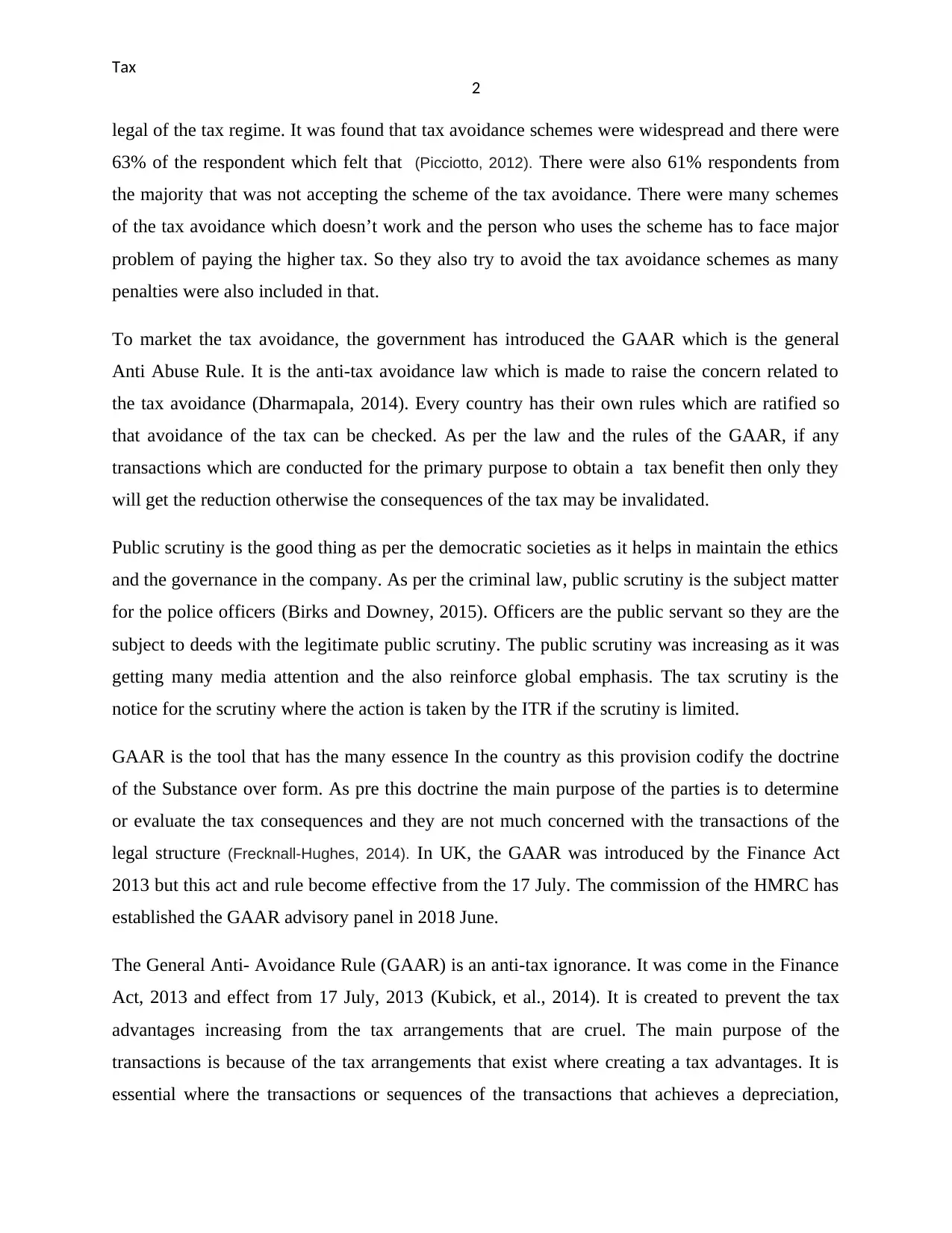
Tax
2
legal of the tax regime. It was found that tax avoidance schemes were widespread and there were
63% of the respondent which felt that (Picciotto, 2012). There were also 61% respondents from
the majority that was not accepting the scheme of the tax avoidance. There were many schemes
of the tax avoidance which doesn’t work and the person who uses the scheme has to face major
problem of paying the higher tax. So they also try to avoid the tax avoidance schemes as many
penalties were also included in that.
To market the tax avoidance, the government has introduced the GAAR which is the general
Anti Abuse Rule. It is the anti-tax avoidance law which is made to raise the concern related to
the tax avoidance (Dharmapala, 2014). Every country has their own rules which are ratified so
that avoidance of the tax can be checked. As per the law and the rules of the GAAR, if any
transactions which are conducted for the primary purpose to obtain a tax benefit then only they
will get the reduction otherwise the consequences of the tax may be invalidated.
Public scrutiny is the good thing as per the democratic societies as it helps in maintain the ethics
and the governance in the company. As per the criminal law, public scrutiny is the subject matter
for the police officers (Birks and Downey, 2015). Officers are the public servant so they are the
subject to deeds with the legitimate public scrutiny. The public scrutiny was increasing as it was
getting many media attention and the also reinforce global emphasis. The tax scrutiny is the
notice for the scrutiny where the action is taken by the ITR if the scrutiny is limited.
GAAR is the tool that has the many essence In the country as this provision codify the doctrine
of the Substance over form. As pre this doctrine the main purpose of the parties is to determine
or evaluate the tax consequences and they are not much concerned with the transactions of the
legal structure (Frecknall-Hughes, 2014). In UK, the GAAR was introduced by the Finance Act
2013 but this act and rule become effective from the 17 July. The commission of the HMRC has
established the GAAR advisory panel in 2018 June.
The General Anti- Avoidance Rule (GAAR) is an anti-tax ignorance. It was come in the Finance
Act, 2013 and effect from 17 July, 2013 (Kubick, et al., 2014). It is created to prevent the tax
advantages increasing from the tax arrangements that are cruel. The main purpose of the
transactions is because of the tax arrangements that exist where creating a tax advantages. It is
essential where the transactions or sequences of the transactions that achieves a depreciation,
2
legal of the tax regime. It was found that tax avoidance schemes were widespread and there were
63% of the respondent which felt that (Picciotto, 2012). There were also 61% respondents from
the majority that was not accepting the scheme of the tax avoidance. There were many schemes
of the tax avoidance which doesn’t work and the person who uses the scheme has to face major
problem of paying the higher tax. So they also try to avoid the tax avoidance schemes as many
penalties were also included in that.
To market the tax avoidance, the government has introduced the GAAR which is the general
Anti Abuse Rule. It is the anti-tax avoidance law which is made to raise the concern related to
the tax avoidance (Dharmapala, 2014). Every country has their own rules which are ratified so
that avoidance of the tax can be checked. As per the law and the rules of the GAAR, if any
transactions which are conducted for the primary purpose to obtain a tax benefit then only they
will get the reduction otherwise the consequences of the tax may be invalidated.
Public scrutiny is the good thing as per the democratic societies as it helps in maintain the ethics
and the governance in the company. As per the criminal law, public scrutiny is the subject matter
for the police officers (Birks and Downey, 2015). Officers are the public servant so they are the
subject to deeds with the legitimate public scrutiny. The public scrutiny was increasing as it was
getting many media attention and the also reinforce global emphasis. The tax scrutiny is the
notice for the scrutiny where the action is taken by the ITR if the scrutiny is limited.
GAAR is the tool that has the many essence In the country as this provision codify the doctrine
of the Substance over form. As pre this doctrine the main purpose of the parties is to determine
or evaluate the tax consequences and they are not much concerned with the transactions of the
legal structure (Frecknall-Hughes, 2014). In UK, the GAAR was introduced by the Finance Act
2013 but this act and rule become effective from the 17 July. The commission of the HMRC has
established the GAAR advisory panel in 2018 June.
The General Anti- Avoidance Rule (GAAR) is an anti-tax ignorance. It was come in the Finance
Act, 2013 and effect from 17 July, 2013 (Kubick, et al., 2014). It is created to prevent the tax
advantages increasing from the tax arrangements that are cruel. The main purpose of the
transactions is because of the tax arrangements that exist where creating a tax advantages. It is
essential where the transactions or sequences of the transactions that achieves a depreciation,
⊘ This is a preview!⊘
Do you want full access?
Subscribe today to unlock all pages.

Trusted by 1+ million students worldwide
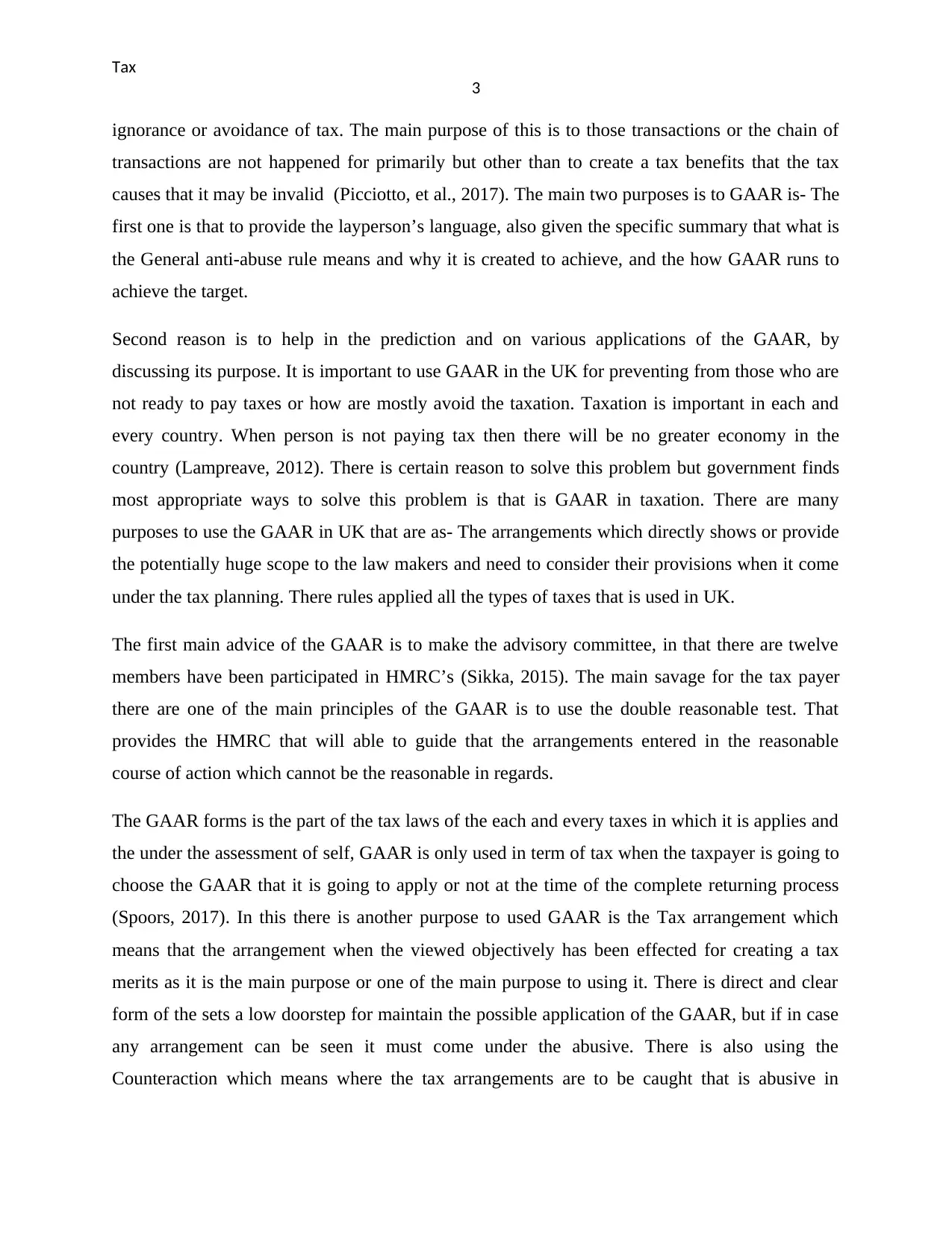
Tax
3
ignorance or avoidance of tax. The main purpose of this is to those transactions or the chain of
transactions are not happened for primarily but other than to create a tax benefits that the tax
causes that it may be invalid (Picciotto, et al., 2017). The main two purposes is to GAAR is- The
first one is that to provide the layperson’s language, also given the specific summary that what is
the General anti-abuse rule means and why it is created to achieve, and the how GAAR runs to
achieve the target.
Second reason is to help in the prediction and on various applications of the GAAR, by
discussing its purpose. It is important to use GAAR in the UK for preventing from those who are
not ready to pay taxes or how are mostly avoid the taxation. Taxation is important in each and
every country. When person is not paying tax then there will be no greater economy in the
country (Lampreave, 2012). There is certain reason to solve this problem but government finds
most appropriate ways to solve this problem is that is GAAR in taxation. There are many
purposes to use the GAAR in UK that are as- The arrangements which directly shows or provide
the potentially huge scope to the law makers and need to consider their provisions when it come
under the tax planning. There rules applied all the types of taxes that is used in UK.
The first main advice of the GAAR is to make the advisory committee, in that there are twelve
members have been participated in HMRC’s (Sikka, 2015). The main savage for the tax payer
there are one of the main principles of the GAAR is to use the double reasonable test. That
provides the HMRC that will able to guide that the arrangements entered in the reasonable
course of action which cannot be the reasonable in regards.
The GAAR forms is the part of the tax laws of the each and every taxes in which it is applies and
the under the assessment of self, GAAR is only used in term of tax when the taxpayer is going to
choose the GAAR that it is going to apply or not at the time of the complete returning process
(Spoors, 2017). In this there is another purpose to used GAAR is the Tax arrangement which
means that the arrangement when the viewed objectively has been effected for creating a tax
merits as it is the main purpose or one of the main purpose to using it. There is direct and clear
form of the sets a low doorstep for maintain the possible application of the GAAR, but if in case
any arrangement can be seen it must come under the abusive. There is also using the
Counteraction which means where the tax arrangements are to be caught that is abusive in
3
ignorance or avoidance of tax. The main purpose of this is to those transactions or the chain of
transactions are not happened for primarily but other than to create a tax benefits that the tax
causes that it may be invalid (Picciotto, et al., 2017). The main two purposes is to GAAR is- The
first one is that to provide the layperson’s language, also given the specific summary that what is
the General anti-abuse rule means and why it is created to achieve, and the how GAAR runs to
achieve the target.
Second reason is to help in the prediction and on various applications of the GAAR, by
discussing its purpose. It is important to use GAAR in the UK for preventing from those who are
not ready to pay taxes or how are mostly avoid the taxation. Taxation is important in each and
every country. When person is not paying tax then there will be no greater economy in the
country (Lampreave, 2012). There is certain reason to solve this problem but government finds
most appropriate ways to solve this problem is that is GAAR in taxation. There are many
purposes to use the GAAR in UK that are as- The arrangements which directly shows or provide
the potentially huge scope to the law makers and need to consider their provisions when it come
under the tax planning. There rules applied all the types of taxes that is used in UK.
The first main advice of the GAAR is to make the advisory committee, in that there are twelve
members have been participated in HMRC’s (Sikka, 2015). The main savage for the tax payer
there are one of the main principles of the GAAR is to use the double reasonable test. That
provides the HMRC that will able to guide that the arrangements entered in the reasonable
course of action which cannot be the reasonable in regards.
The GAAR forms is the part of the tax laws of the each and every taxes in which it is applies and
the under the assessment of self, GAAR is only used in term of tax when the taxpayer is going to
choose the GAAR that it is going to apply or not at the time of the complete returning process
(Spoors, 2017). In this there is another purpose to used GAAR is the Tax arrangement which
means that the arrangement when the viewed objectively has been effected for creating a tax
merits as it is the main purpose or one of the main purpose to using it. There is direct and clear
form of the sets a low doorstep for maintain the possible application of the GAAR, but if in case
any arrangement can be seen it must come under the abusive. There is also using the
Counteraction which means where the tax arrangements are to be caught that is abusive in
Paraphrase This Document
Need a fresh take? Get an instant paraphrase of this document with our AI Paraphraser
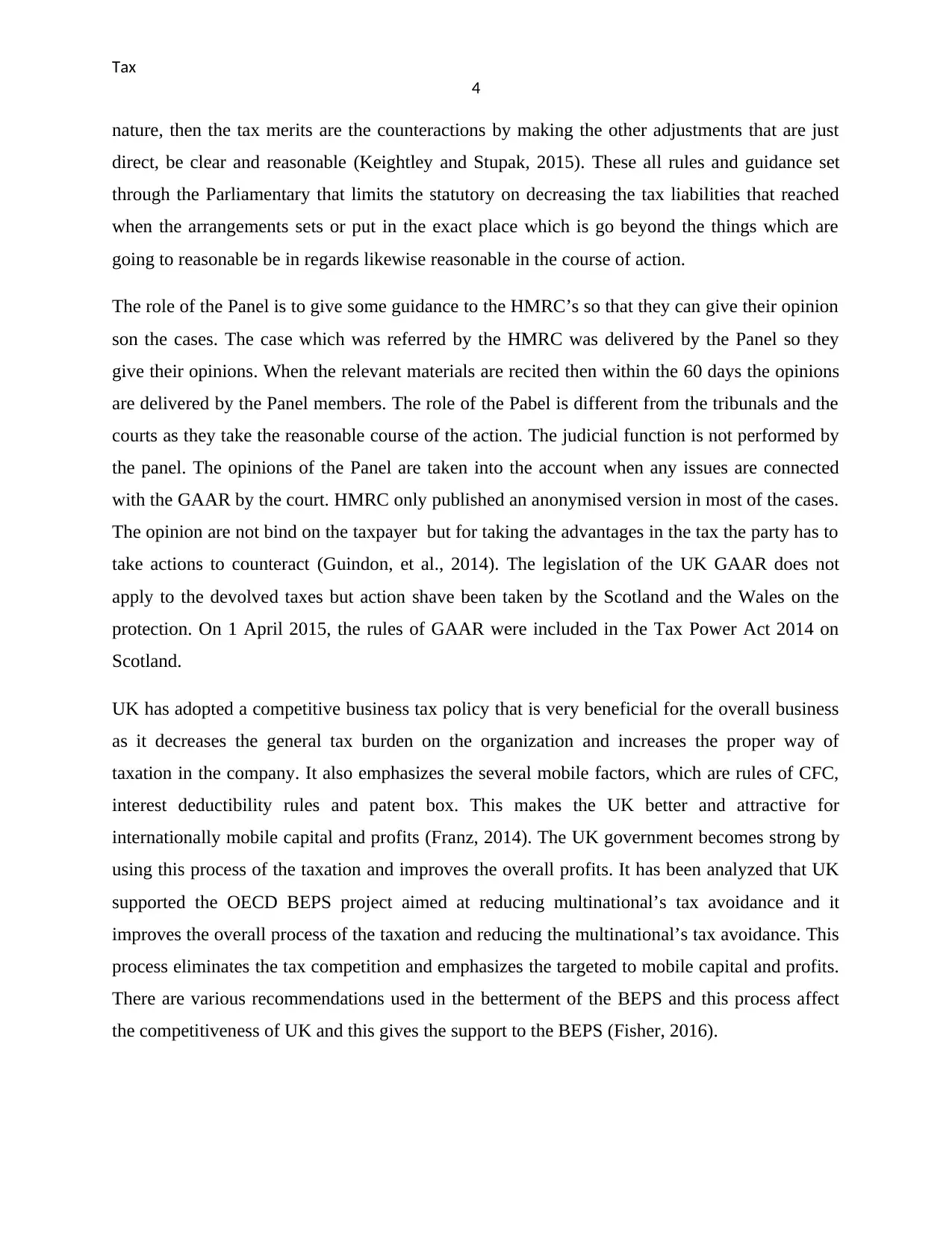
Tax
4
nature, then the tax merits are the counteractions by making the other adjustments that are just
direct, be clear and reasonable (Keightley and Stupak, 2015). These all rules and guidance set
through the Parliamentary that limits the statutory on decreasing the tax liabilities that reached
when the arrangements sets or put in the exact place which is go beyond the things which are
going to reasonable be in regards likewise reasonable in the course of action.
The role of the Panel is to give some guidance to the HMRC’s so that they can give their opinion
son the cases. The case which was referred by the HMRC was delivered by the Panel so they
give their opinions. When the relevant materials are recited then within the 60 days the opinions
are delivered by the Panel members. The role of the Pabel is different from the tribunals and the
courts as they take the reasonable course of the action. The judicial function is not performed by
the panel. The opinions of the Panel are taken into the account when any issues are connected
with the GAAR by the court. HMRC only published an anonymised version in most of the cases.
The opinion are not bind on the taxpayer but for taking the advantages in the tax the party has to
take actions to counteract (Guindon, et al., 2014). The legislation of the UK GAAR does not
apply to the devolved taxes but action shave been taken by the Scotland and the Wales on the
protection. On 1 April 2015, the rules of GAAR were included in the Tax Power Act 2014 on
Scotland.
UK has adopted a competitive business tax policy that is very beneficial for the overall business
as it decreases the general tax burden on the organization and increases the proper way of
taxation in the company. It also emphasizes the several mobile factors, which are rules of CFC,
interest deductibility rules and patent box. This makes the UK better and attractive for
internationally mobile capital and profits (Franz, 2014). The UK government becomes strong by
using this process of the taxation and improves the overall profits. It has been analyzed that UK
supported the OECD BEPS project aimed at reducing multinational’s tax avoidance and it
improves the overall process of the taxation and reducing the multinational’s tax avoidance. This
process eliminates the tax competition and emphasizes the targeted to mobile capital and profits.
There are various recommendations used in the betterment of the BEPS and this process affect
the competitiveness of UK and this gives the support to the BEPS (Fisher, 2016).
4
nature, then the tax merits are the counteractions by making the other adjustments that are just
direct, be clear and reasonable (Keightley and Stupak, 2015). These all rules and guidance set
through the Parliamentary that limits the statutory on decreasing the tax liabilities that reached
when the arrangements sets or put in the exact place which is go beyond the things which are
going to reasonable be in regards likewise reasonable in the course of action.
The role of the Panel is to give some guidance to the HMRC’s so that they can give their opinion
son the cases. The case which was referred by the HMRC was delivered by the Panel so they
give their opinions. When the relevant materials are recited then within the 60 days the opinions
are delivered by the Panel members. The role of the Pabel is different from the tribunals and the
courts as they take the reasonable course of the action. The judicial function is not performed by
the panel. The opinions of the Panel are taken into the account when any issues are connected
with the GAAR by the court. HMRC only published an anonymised version in most of the cases.
The opinion are not bind on the taxpayer but for taking the advantages in the tax the party has to
take actions to counteract (Guindon, et al., 2014). The legislation of the UK GAAR does not
apply to the devolved taxes but action shave been taken by the Scotland and the Wales on the
protection. On 1 April 2015, the rules of GAAR were included in the Tax Power Act 2014 on
Scotland.
UK has adopted a competitive business tax policy that is very beneficial for the overall business
as it decreases the general tax burden on the organization and increases the proper way of
taxation in the company. It also emphasizes the several mobile factors, which are rules of CFC,
interest deductibility rules and patent box. This makes the UK better and attractive for
internationally mobile capital and profits (Franz, 2014). The UK government becomes strong by
using this process of the taxation and improves the overall profits. It has been analyzed that UK
supported the OECD BEPS project aimed at reducing multinational’s tax avoidance and it
improves the overall process of the taxation and reducing the multinational’s tax avoidance. This
process eliminates the tax competition and emphasizes the targeted to mobile capital and profits.
There are various recommendations used in the betterment of the BEPS and this process affect
the competitiveness of UK and this gives the support to the BEPS (Fisher, 2016).
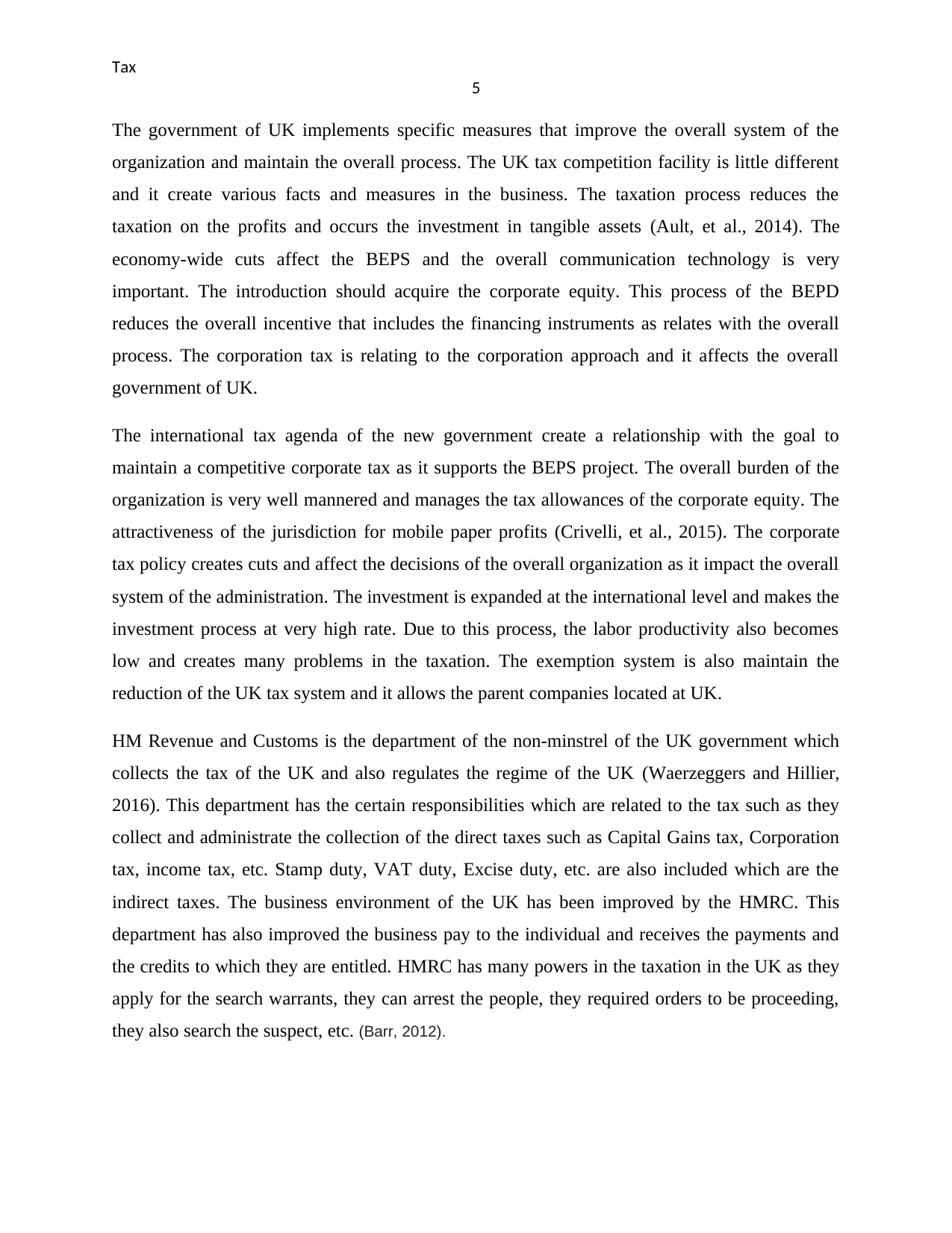
Tax
5
The government of UK implements specific measures that improve the overall system of the
organization and maintain the overall process. The UK tax competition facility is little different
and it create various facts and measures in the business. The taxation process reduces the
taxation on the profits and occurs the investment in tangible assets (Ault, et al., 2014). The
economy-wide cuts affect the BEPS and the overall communication technology is very
important. The introduction should acquire the corporate equity. This process of the BEPD
reduces the overall incentive that includes the financing instruments as relates with the overall
process. The corporation tax is relating to the corporation approach and it affects the overall
government of UK.
The international tax agenda of the new government create a relationship with the goal to
maintain a competitive corporate tax as it supports the BEPS project. The overall burden of the
organization is very well mannered and manages the tax allowances of the corporate equity. The
attractiveness of the jurisdiction for mobile paper profits (Crivelli, et al., 2015). The corporate
tax policy creates cuts and affect the decisions of the overall organization as it impact the overall
system of the administration. The investment is expanded at the international level and makes the
investment process at very high rate. Due to this process, the labor productivity also becomes
low and creates many problems in the taxation. The exemption system is also maintain the
reduction of the UK tax system and it allows the parent companies located at UK.
HM Revenue and Customs is the department of the non-minstrel of the UK government which
collects the tax of the UK and also regulates the regime of the UK (Waerzeggers and Hillier,
2016). This department has the certain responsibilities which are related to the tax such as they
collect and administrate the collection of the direct taxes such as Capital Gains tax, Corporation
tax, income tax, etc. Stamp duty, VAT duty, Excise duty, etc. are also included which are the
indirect taxes. The business environment of the UK has been improved by the HMRC. This
department has also improved the business pay to the individual and receives the payments and
the credits to which they are entitled. HMRC has many powers in the taxation in the UK as they
apply for the search warrants, they can arrest the people, they required orders to be proceeding,
they also search the suspect, etc. (Barr, 2012).
5
The government of UK implements specific measures that improve the overall system of the
organization and maintain the overall process. The UK tax competition facility is little different
and it create various facts and measures in the business. The taxation process reduces the
taxation on the profits and occurs the investment in tangible assets (Ault, et al., 2014). The
economy-wide cuts affect the BEPS and the overall communication technology is very
important. The introduction should acquire the corporate equity. This process of the BEPD
reduces the overall incentive that includes the financing instruments as relates with the overall
process. The corporation tax is relating to the corporation approach and it affects the overall
government of UK.
The international tax agenda of the new government create a relationship with the goal to
maintain a competitive corporate tax as it supports the BEPS project. The overall burden of the
organization is very well mannered and manages the tax allowances of the corporate equity. The
attractiveness of the jurisdiction for mobile paper profits (Crivelli, et al., 2015). The corporate
tax policy creates cuts and affect the decisions of the overall organization as it impact the overall
system of the administration. The investment is expanded at the international level and makes the
investment process at very high rate. Due to this process, the labor productivity also becomes
low and creates many problems in the taxation. The exemption system is also maintain the
reduction of the UK tax system and it allows the parent companies located at UK.
HM Revenue and Customs is the department of the non-minstrel of the UK government which
collects the tax of the UK and also regulates the regime of the UK (Waerzeggers and Hillier,
2016). This department has the certain responsibilities which are related to the tax such as they
collect and administrate the collection of the direct taxes such as Capital Gains tax, Corporation
tax, income tax, etc. Stamp duty, VAT duty, Excise duty, etc. are also included which are the
indirect taxes. The business environment of the UK has been improved by the HMRC. This
department has also improved the business pay to the individual and receives the payments and
the credits to which they are entitled. HMRC has many powers in the taxation in the UK as they
apply for the search warrants, they can arrest the people, they required orders to be proceeding,
they also search the suspect, etc. (Barr, 2012).
⊘ This is a preview!⊘
Do you want full access?
Subscribe today to unlock all pages.

Trusted by 1+ million students worldwide
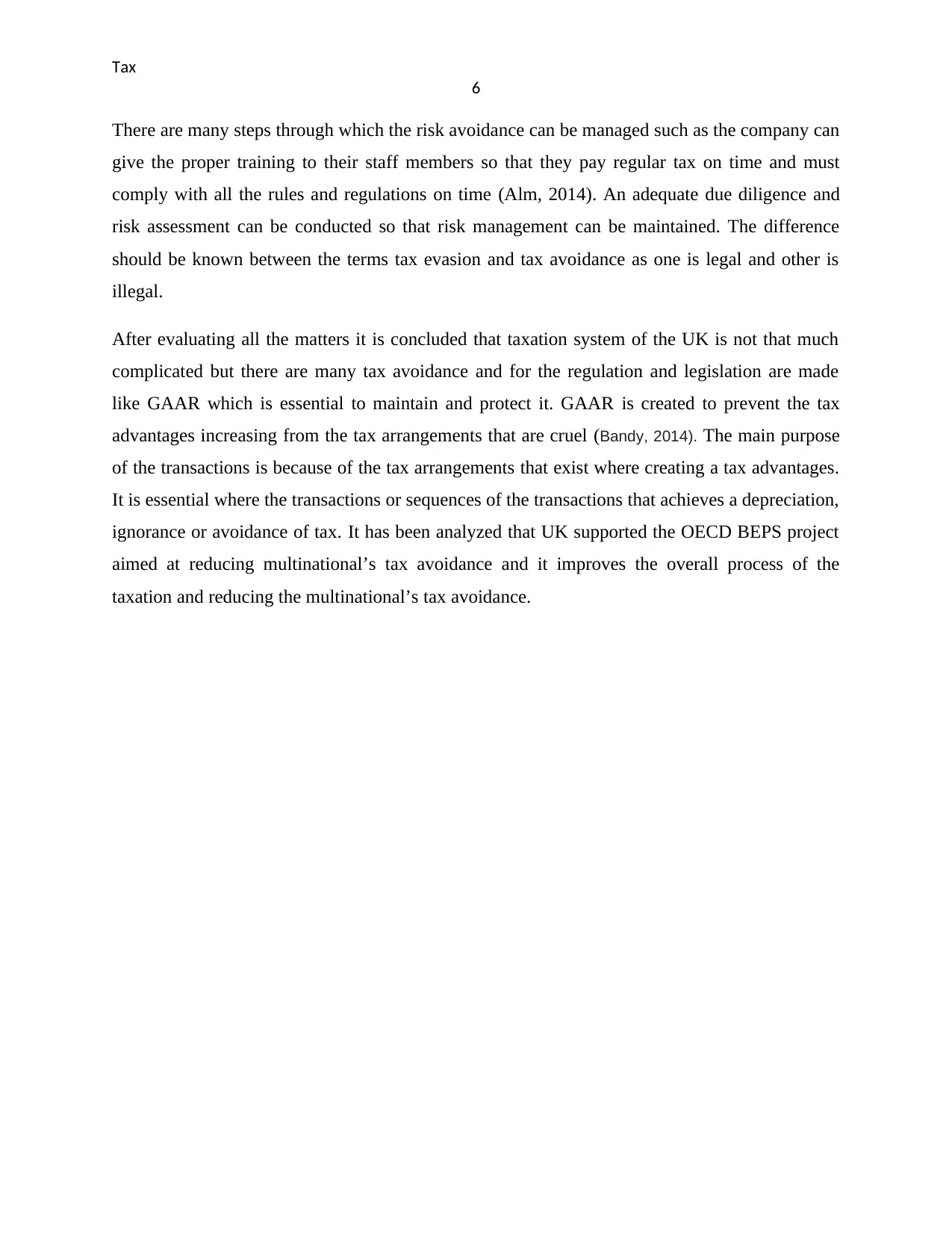
Tax
6
There are many steps through which the risk avoidance can be managed such as the company can
give the proper training to their staff members so that they pay regular tax on time and must
comply with all the rules and regulations on time (Alm, 2014). An adequate due diligence and
risk assessment can be conducted so that risk management can be maintained. The difference
should be known between the terms tax evasion and tax avoidance as one is legal and other is
illegal.
After evaluating all the matters it is concluded that taxation system of the UK is not that much
complicated but there are many tax avoidance and for the regulation and legislation are made
like GAAR which is essential to maintain and protect it. GAAR is created to prevent the tax
advantages increasing from the tax arrangements that are cruel (Bandy, 2014). The main purpose
of the transactions is because of the tax arrangements that exist where creating a tax advantages.
It is essential where the transactions or sequences of the transactions that achieves a depreciation,
ignorance or avoidance of tax. It has been analyzed that UK supported the OECD BEPS project
aimed at reducing multinational’s tax avoidance and it improves the overall process of the
taxation and reducing the multinational’s tax avoidance.
6
There are many steps through which the risk avoidance can be managed such as the company can
give the proper training to their staff members so that they pay regular tax on time and must
comply with all the rules and regulations on time (Alm, 2014). An adequate due diligence and
risk assessment can be conducted so that risk management can be maintained. The difference
should be known between the terms tax evasion and tax avoidance as one is legal and other is
illegal.
After evaluating all the matters it is concluded that taxation system of the UK is not that much
complicated but there are many tax avoidance and for the regulation and legislation are made
like GAAR which is essential to maintain and protect it. GAAR is created to prevent the tax
advantages increasing from the tax arrangements that are cruel (Bandy, 2014). The main purpose
of the transactions is because of the tax arrangements that exist where creating a tax advantages.
It is essential where the transactions or sequences of the transactions that achieves a depreciation,
ignorance or avoidance of tax. It has been analyzed that UK supported the OECD BEPS project
aimed at reducing multinational’s tax avoidance and it improves the overall process of the
taxation and reducing the multinational’s tax avoidance.
Paraphrase This Document
Need a fresh take? Get an instant paraphrase of this document with our AI Paraphraser
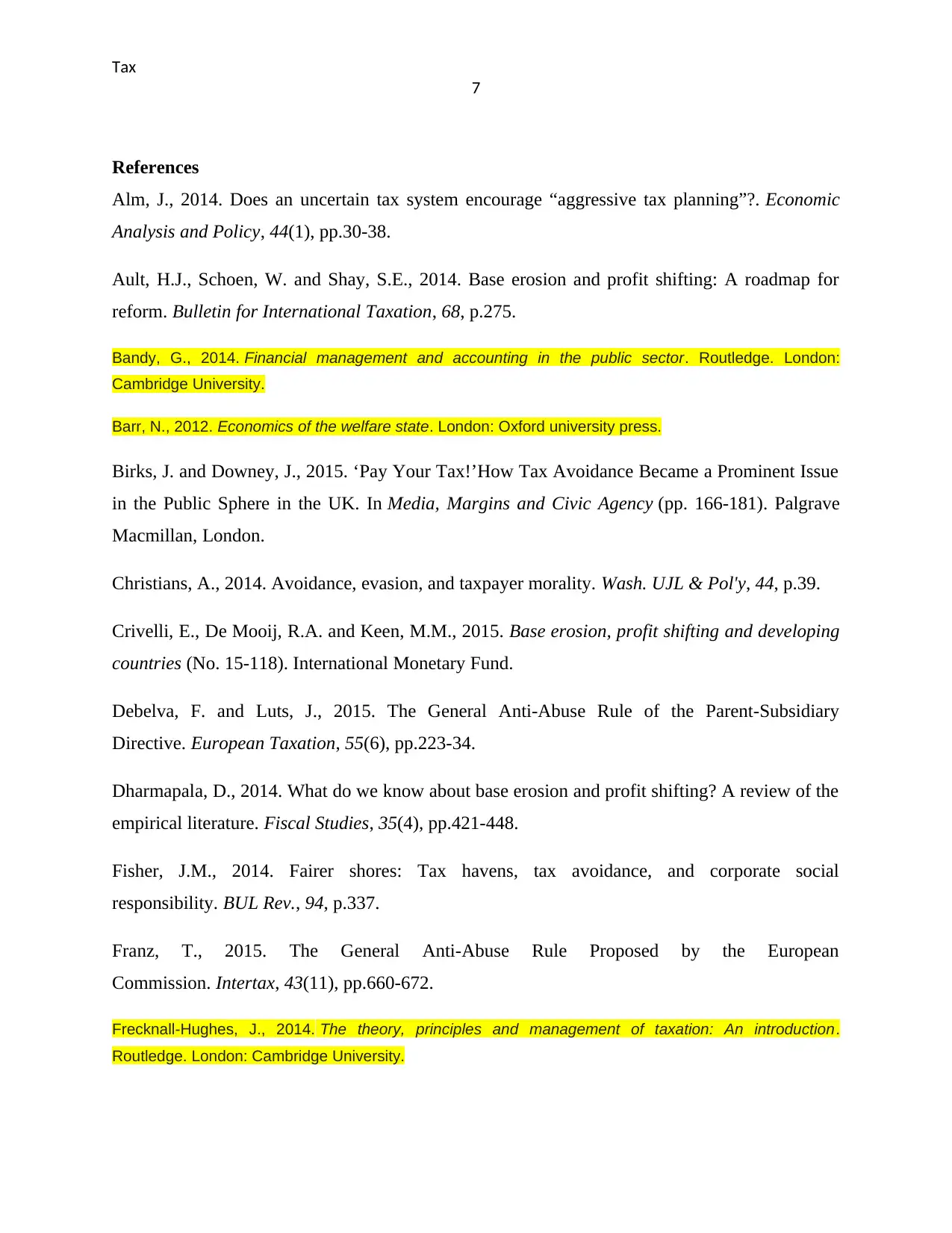
Tax
7
References
Alm, J., 2014. Does an uncertain tax system encourage “aggressive tax planning”?. Economic
Analysis and Policy, 44(1), pp.30-38.
Ault, H.J., Schoen, W. and Shay, S.E., 2014. Base erosion and profit shifting: A roadmap for
reform. Bulletin for International Taxation, 68, p.275.
Bandy, G., 2014. Financial management and accounting in the public sector. Routledge. London:
Cambridge University.
Barr, N., 2012. Economics of the welfare state. London: Oxford university press.
Birks, J. and Downey, J., 2015. ‘Pay Your Tax!’How Tax Avoidance Became a Prominent Issue
in the Public Sphere in the UK. In Media, Margins and Civic Agency (pp. 166-181). Palgrave
Macmillan, London.
Christians, A., 2014. Avoidance, evasion, and taxpayer morality. Wash. UJL & Pol'y, 44, p.39.
Crivelli, E., De Mooij, R.A. and Keen, M.M., 2015. Base erosion, profit shifting and developing
countries (No. 15-118). International Monetary Fund.
Debelva, F. and Luts, J., 2015. The General Anti-Abuse Rule of the Parent-Subsidiary
Directive. European Taxation, 55(6), pp.223-34.
Dharmapala, D., 2014. What do we know about base erosion and profit shifting? A review of the
empirical literature. Fiscal Studies, 35(4), pp.421-448.
Fisher, J.M., 2014. Fairer shores: Tax havens, tax avoidance, and corporate social
responsibility. BUL Rev., 94, p.337.
Franz, T., 2015. The General Anti-Abuse Rule Proposed by the European
Commission. Intertax, 43(11), pp.660-672.
Frecknall-Hughes, J., 2014. The theory, principles and management of taxation: An introduction.
Routledge. London: Cambridge University.
7
References
Alm, J., 2014. Does an uncertain tax system encourage “aggressive tax planning”?. Economic
Analysis and Policy, 44(1), pp.30-38.
Ault, H.J., Schoen, W. and Shay, S.E., 2014. Base erosion and profit shifting: A roadmap for
reform. Bulletin for International Taxation, 68, p.275.
Bandy, G., 2014. Financial management and accounting in the public sector. Routledge. London:
Cambridge University.
Barr, N., 2012. Economics of the welfare state. London: Oxford university press.
Birks, J. and Downey, J., 2015. ‘Pay Your Tax!’How Tax Avoidance Became a Prominent Issue
in the Public Sphere in the UK. In Media, Margins and Civic Agency (pp. 166-181). Palgrave
Macmillan, London.
Christians, A., 2014. Avoidance, evasion, and taxpayer morality. Wash. UJL & Pol'y, 44, p.39.
Crivelli, E., De Mooij, R.A. and Keen, M.M., 2015. Base erosion, profit shifting and developing
countries (No. 15-118). International Monetary Fund.
Debelva, F. and Luts, J., 2015. The General Anti-Abuse Rule of the Parent-Subsidiary
Directive. European Taxation, 55(6), pp.223-34.
Dharmapala, D., 2014. What do we know about base erosion and profit shifting? A review of the
empirical literature. Fiscal Studies, 35(4), pp.421-448.
Fisher, J.M., 2014. Fairer shores: Tax havens, tax avoidance, and corporate social
responsibility. BUL Rev., 94, p.337.
Franz, T., 2015. The General Anti-Abuse Rule Proposed by the European
Commission. Intertax, 43(11), pp.660-672.
Frecknall-Hughes, J., 2014. The theory, principles and management of taxation: An introduction.
Routledge. London: Cambridge University.
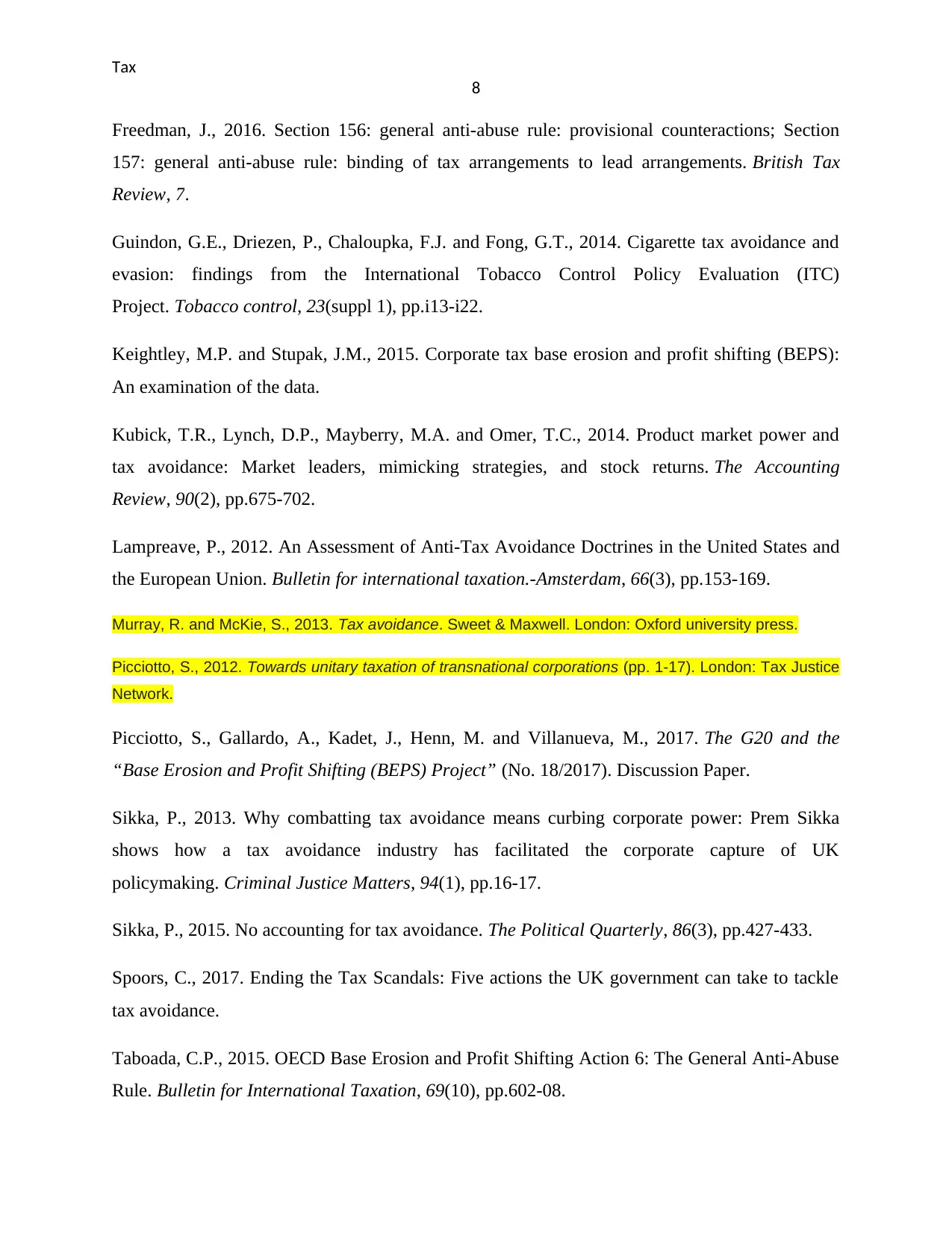
Tax
8
Freedman, J., 2016. Section 156: general anti-abuse rule: provisional counteractions; Section
157: general anti-abuse rule: binding of tax arrangements to lead arrangements. British Tax
Review, 7.
Guindon, G.E., Driezen, P., Chaloupka, F.J. and Fong, G.T., 2014. Cigarette tax avoidance and
evasion: findings from the International Tobacco Control Policy Evaluation (ITC)
Project. Tobacco control, 23(suppl 1), pp.i13-i22.
Keightley, M.P. and Stupak, J.M., 2015. Corporate tax base erosion and profit shifting (BEPS):
An examination of the data.
Kubick, T.R., Lynch, D.P., Mayberry, M.A. and Omer, T.C., 2014. Product market power and
tax avoidance: Market leaders, mimicking strategies, and stock returns. The Accounting
Review, 90(2), pp.675-702.
Lampreave, P., 2012. An Assessment of Anti-Tax Avoidance Doctrines in the United States and
the European Union. Bulletin for international taxation.-Amsterdam, 66(3), pp.153-169.
Murray, R. and McKie, S., 2013. Tax avoidance. Sweet & Maxwell. London: Oxford university press.
Picciotto, S., 2012. Towards unitary taxation of transnational corporations (pp. 1-17). London: Tax Justice
Network.
Picciotto, S., Gallardo, A., Kadet, J., Henn, M. and Villanueva, M., 2017. The G20 and the
“Base Erosion and Profit Shifting (BEPS) Project” (No. 18/2017). Discussion Paper.
Sikka, P., 2013. Why combatting tax avoidance means curbing corporate power: Prem Sikka
shows how a tax avoidance industry has facilitated the corporate capture of UK
policymaking. Criminal Justice Matters, 94(1), pp.16-17.
Sikka, P., 2015. No accounting for tax avoidance. The Political Quarterly, 86(3), pp.427-433.
Spoors, C., 2017. Ending the Tax Scandals: Five actions the UK government can take to tackle
tax avoidance.
Taboada, C.P., 2015. OECD Base Erosion and Profit Shifting Action 6: The General Anti-Abuse
Rule. Bulletin for International Taxation, 69(10), pp.602-08.
8
Freedman, J., 2016. Section 156: general anti-abuse rule: provisional counteractions; Section
157: general anti-abuse rule: binding of tax arrangements to lead arrangements. British Tax
Review, 7.
Guindon, G.E., Driezen, P., Chaloupka, F.J. and Fong, G.T., 2014. Cigarette tax avoidance and
evasion: findings from the International Tobacco Control Policy Evaluation (ITC)
Project. Tobacco control, 23(suppl 1), pp.i13-i22.
Keightley, M.P. and Stupak, J.M., 2015. Corporate tax base erosion and profit shifting (BEPS):
An examination of the data.
Kubick, T.R., Lynch, D.P., Mayberry, M.A. and Omer, T.C., 2014. Product market power and
tax avoidance: Market leaders, mimicking strategies, and stock returns. The Accounting
Review, 90(2), pp.675-702.
Lampreave, P., 2012. An Assessment of Anti-Tax Avoidance Doctrines in the United States and
the European Union. Bulletin for international taxation.-Amsterdam, 66(3), pp.153-169.
Murray, R. and McKie, S., 2013. Tax avoidance. Sweet & Maxwell. London: Oxford university press.
Picciotto, S., 2012. Towards unitary taxation of transnational corporations (pp. 1-17). London: Tax Justice
Network.
Picciotto, S., Gallardo, A., Kadet, J., Henn, M. and Villanueva, M., 2017. The G20 and the
“Base Erosion and Profit Shifting (BEPS) Project” (No. 18/2017). Discussion Paper.
Sikka, P., 2013. Why combatting tax avoidance means curbing corporate power: Prem Sikka
shows how a tax avoidance industry has facilitated the corporate capture of UK
policymaking. Criminal Justice Matters, 94(1), pp.16-17.
Sikka, P., 2015. No accounting for tax avoidance. The Political Quarterly, 86(3), pp.427-433.
Spoors, C., 2017. Ending the Tax Scandals: Five actions the UK government can take to tackle
tax avoidance.
Taboada, C.P., 2015. OECD Base Erosion and Profit Shifting Action 6: The General Anti-Abuse
Rule. Bulletin for International Taxation, 69(10), pp.602-08.
⊘ This is a preview!⊘
Do you want full access?
Subscribe today to unlock all pages.

Trusted by 1+ million students worldwide
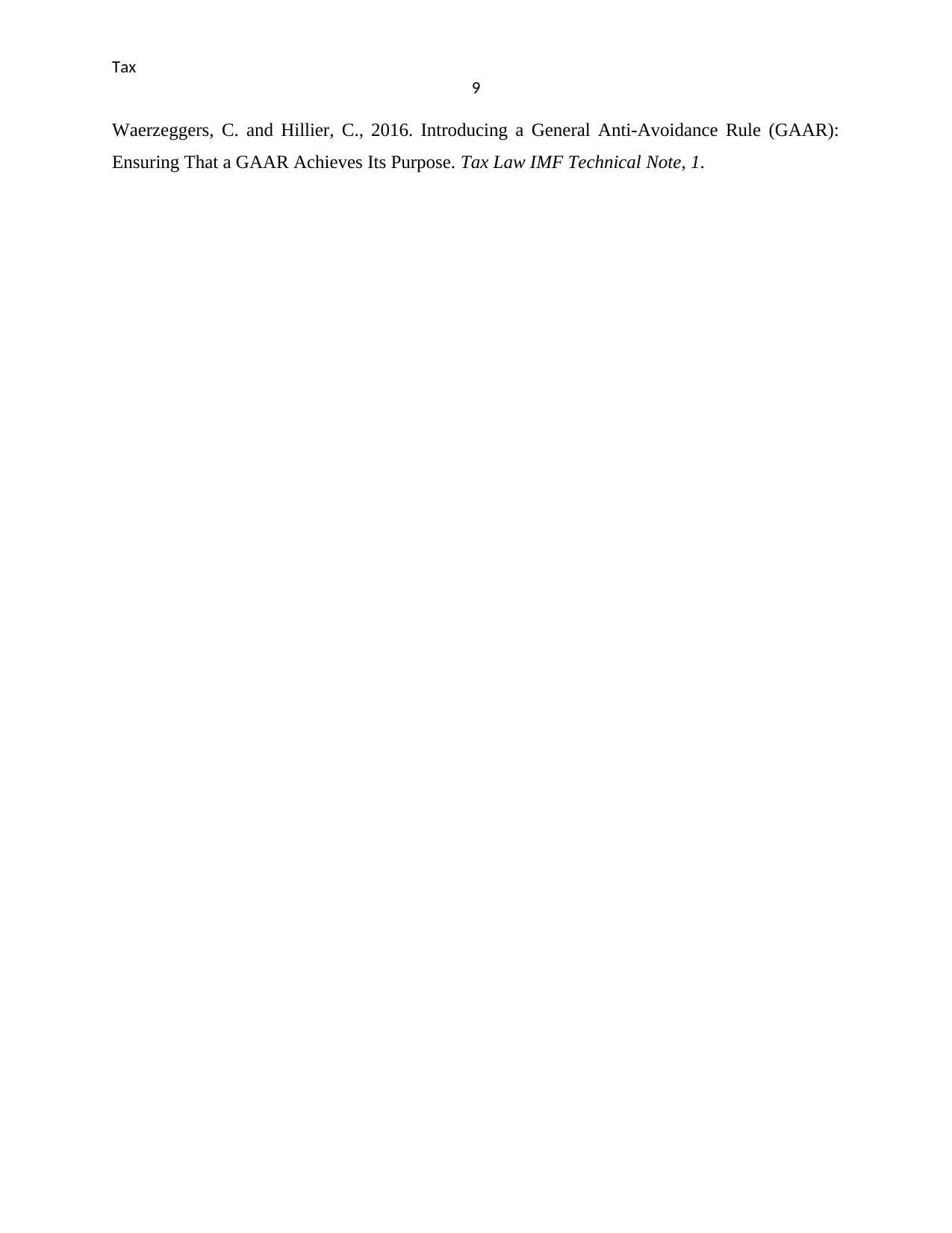
Tax
9
Waerzeggers, C. and Hillier, C., 2016. Introducing a General Anti-Avoidance Rule (GAAR):
Ensuring That a GAAR Achieves Its Purpose. Tax Law IMF Technical Note, 1.
9
Waerzeggers, C. and Hillier, C., 2016. Introducing a General Anti-Avoidance Rule (GAAR):
Ensuring That a GAAR Achieves Its Purpose. Tax Law IMF Technical Note, 1.
1 out of 10
Related Documents
Your All-in-One AI-Powered Toolkit for Academic Success.
+13062052269
info@desklib.com
Available 24*7 on WhatsApp / Email
![[object Object]](/_next/static/media/star-bottom.7253800d.svg)
Unlock your academic potential
Copyright © 2020–2025 A2Z Services. All Rights Reserved. Developed and managed by ZUCOL.




